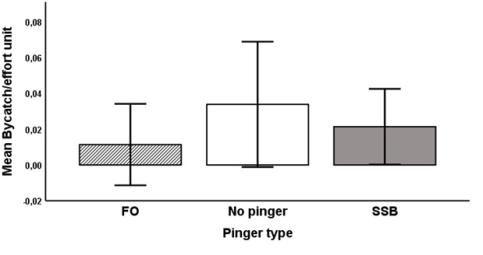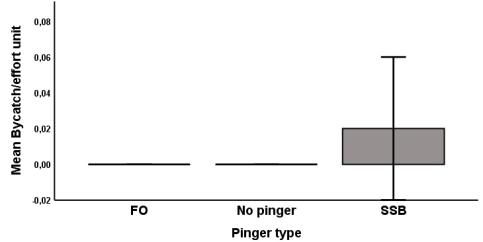Results
Using video footage to verify fishermen logbooks
Pinger efficiency in reducing harbour porpoise presence
Lumpfish fisheries
Using a Kruskal Wallis test for groupwise comparisons and a Mann-Whitney U test for pairwise comparisons revealed the following: In two of three areas with lumpfish as target species, C-PODs attached to gillnets without pingers showed a significantly higher average DPM/h than gillnets with pingers. Furthermore, C-PODs attached to gillnets with SSB pingers showed significantly higher average DPM/h than C-PODs attached to gillnets with FO pingers.
Cod fisheries
C-PODs attached to gillnets without pingers showed error in one area and were excluted in the analysis. Using a Kruskal Wallis test for groupwise comparisons and a Mann-Whitney U test for pairwise comparisons revealed the following: In two out of three areas with Cod as target species, C-PODs attached to gillnets without pingers showed a significantly higher average DPM/h than gillnets with pingers. No significant DPM/h differences could be found between both pinger types, however DPM/h was low in areas with cod. Furthermore, only two out of the four areas with cod as target species tested the Future Oceans F70 pinger.
Bycatch reducing efficiency of pingers

Lumpfish fisheries
Gillnet length and soak time differed between participating fishermen. Thus, the probability of bycatch differed between areas. Bycatch frequencies were therefore calculated by “Bycatch/effort unit, where effort is based on the gillnet length and soak time during periods with confirmed bycatch. Since the bycatch frequencies were not normal distributed, a Kruskal Wallis test was performed to investigate bycatch differences between gillnets with SSB pingers, gillnets with FO pingers and gillnets without pingers.
The Kruskal Wallis test revealed no significant difference in bycatch frequency between the three experimental set-ups (p = 0.240). A subsequent power analysis revealed an observed power of 0.166, which means that the sample size was not large enough to determine a statistical significance. However, the data presented here shows a possible trend, where gillnets without pingers had a higher bycatch frequency than gillnets with SSB pingers and FO pingers respectively. Likewise, gillnets with SSB pingers had a higher bycatch frequency than gillnets with FO pingers.
Cod fisheries

The Kruskal Wallis test revealed no significant difference in bycatch frequency between the three experimental set-ups (p = 0.525) Similar to the areas with lumpfish as target species, a power analysis revealed an observed power of 0.157 from this sample, which means that the sample size was not large enough to determine a statistical significance. There was only one instance of bycatch of harbour porpoise in areas with cod as target species, thus, no assumptions can be made regarding possible bycatch trends in areas with cod as target species.
Responsible for this page:
Director of undergraduate studies Biology
Last updated:
05/30/20
